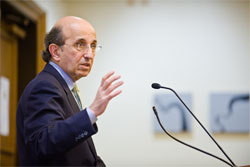Real-World Lessons on Recruiting and Developing Quality Teachers
The experiences of five urban school districts, one state and three education entrepreneur organizations offer new insights into the effective recruitment, development and retention of top-quality teachers.
These experiences are captured in a group of case studies released today by a project of the Consortium for Policy Research in Education (CPRE), the nation’s oldest federally funded education policy center, of which Teachers College President Susan Fuhrman is the founding director.
The urban districts studied by the project -- known as the Strategic Management of Human Capital (SMHC) -- were Boston, Chicago, Fairfax County (Virginia), Long Beach (California) and New York City. The state studied was
To read each of SMHC case studies, visit www.smhc-cpre.org. The following are some of the key findings of the SMHC project:
The five urban districts all worked over time to identify both traditional and new sources of high-quality teachers and principals.
In order to be able to offer jobs to well-qualified candidates in a timely manner, the districts studied moved up their budget calendars and transfer schedules so that hiring decisions could be made in late winter or early spring. The districts also significantly changed seniority transfer policies, giving schools the sole power to make final decision on which teachers to hire, and typically eliminating seniority “bumping.”
The districts studied have restructured many human resources processes in order to support recruitment and retention of high-quality teachers. These include enabling HR operations to provide localized support; using technology to ensure efficiency and accuracy of recruitment and screening (including teacher-specific websites); and, in the case of New York City, linking the application process to the school payroll system to pay teachers on time.
Most of the case study sites have created – and, in many cases, are refining -- induction and mentoring programs for new teachers (and sometimes new principals). These programs include mentoring in the first two years, connected to state teaching standards, and voluntary online support. Efforts in both areas are modeled after the programs of the
Professional development of teachers is not linked to teaching standards or evaluations, and overall there is a lack of connection between teacher professional development and principal professional development.
In the area of performance management, peer review is used in
Regarding teacher compensation, the districts studied offer credit on the salary for specializations and acting as mentors/coaches. They also offer additional pay for additional time worked in hard-to-staff schools. Principals’ compensation is based on established salary schedules and the size of the schools. In
All five districts have had stable leadership at the top for several years. Union-management collaboration has been requisite for many of the advances made in the districts’ strategic management of human capital.
SHMC, based at the
Published Tuesday, Nov. 18, 2008
